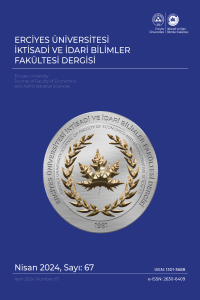Öz
In this study, we investigated the effect of workers’ remittances on foreign debt. For this purpose, we analyzed the upper-middle income countries for the period 1998-2019 by employing the GMM (generalized method of moments) estimator. According to the results of the analysis, workers’ remittances affect foreign debt negatively. Other variables that have a negative impact on external debt are openness and domestic savings. It has been also determined that inflation, government expenditure and nominal exchange rate have positive effects on foreign debt. In this case, it can be said that policies which encourage savings, remittances and foreign trade should be implemented in order to reduce dependence on foreign debt. In addition, targeting a low inflation rate, exchange rate and budget deficit may contribute to reduction of the external borrowing burden.
Anahtar Kelimeler
Kaynakça
- Abbas, S., ve Wizarat, S. (2018). Military expenditure and external debt in south Asia: A panel data analysis. Peace Economics, Peace Science and Public Policy, 24(3), 1–7. https://doi.org/10.1515/peps-2017-0045
- Abd Rahman, N.H., Ismail, S., Abd Samad, K., Handayani, B.D., Rahman, Y.A., ve Sakitri, W. (2022). The Effects of Regulatory Performance on the Debt–Growth Relationship: Cases of Upper-Middle-Income Economies. Economies 10(10), 235, 1-14. https://doi.org/10.3390/economies10100235
- Abdullahi, M.M., Bakar, N.A.A., ve Hassan, S.B. (2015). Determining the macroeconomic factors of external debt accumulation in Nigeria: An ARDL bound test approach. Procedia - Social and Behavioral Sciences, 21, 745 – 752. https://doi.org/10.1016/j.sbspro.2015.11.098
- Adamu, I. M. (2019). Re-visiting the drivers for increasing external debt. Journal of Contemporary Issues and Thought, 9 (June): 40–53. https://doi.org/10.37134/jcit.vol9. 5.2019
- Adane, O., Mulugeta, W., ve Melaka. T. (2018). Determinants of external debt in Ethiopia. Horn of Africa Journal of Business and Economics (HAJBE), 1(2), 1-16. https://ejhs.ju.edu.et/index.php/jbeco/article/view/604
- Aladejare, S.A. (2023). How significant is trade, macroeconomic management, and economic integration for foreign indebtedness in West African Countries? https://doi.org/10.21203/rs.3.rs-2559805/v1
- Al-Fawwaz, T. M. (2016). Determinants of external debt in Jordan: an empirical study (1990-2014). International Business Research, 9(7),116-123.http://dx.doi.org/10.5539/ibr.v9n7p116
- Anderson, T. W., ve Hsiao, C. (1981). Estimation of dynamic models with error components, Journal of the American Statistical Association, 76(375), 598–606. https://doi.org/10.2307/2287517
- Anoruo, E., Young, D., ve Ahmad, Y. (2006). Dynamics of external debts among heavily indebted poor countries (HIPCs): A Panel data approach. Journal of International Business Research, 5(1), 41-52. https://www.proquest.com/docview/215464075/fulltextPDF/70A594DEF1024388PQ/1?accountid=12398
- Arellano, M. B., ve Bond, S. (1991). Some tests of specification for panel data: Monte Carlo evidence and an application to employment equations. The Review of Economic Studies,58(2), 277–97. https://doi.org/10.2307/2297968
- Asghar, N., Amjad, M. A., ve Rehman, H. (2022). Historical perspective of external debt in Pakistan: identifying key determinants/strategies. Review of Economics and Development Studies, 8(1), 13-24. https://doi.org/10.47067/reads.v8i1.427
- Atique, R., ve Malik, K. (2012). Impact of domestic and external debt on the economic growth of Pakistan. World Applied Sciences Journal, 20(1), 120-129. DOI:10.5829/idosi.wasj.2012.20.01.1621
- Awan, A., Asghar, N., ve Rehman, H. (2011). The impact of exchange rate, fiscal deficit and terms of trade on external debt of Pakistan: a cointegration and causality analysis. Australian Journal of Business and Management Research, 1(3), 10-24. 10.52283/NSWRCA.AJBMR.20110103A02
- Awan, R.U., Anjum, A., ve Rehim, S. (2014). An econometric analysis of determinants of external debt. A case of Pakistan. British Journal of Economics, Management & Trade, 5(4), 382–391. DOI:https://doi.org/10.9734/BJEMT/2015/8837
- Azolibe, C. B. (2020). Determinants of external indebtedness in heavily indebted poor countries: What macroeconomic and socio-economic factors matter?. The American Economist, 66(2),1–16. https://doi.org/10.1177/0569434520938326
- Beyene, S. D., ve Kotosz, B.(2020a). Macroeconomic determinants of external indebtedness of Ethiopia: ardl approach to cointegration. Society and Economy, 42(3),313–332. https://doi.org/10.1556/204.2020.00013.
- Beyene, S. D., ve Kotosz, B. (2020b). Determinants of external indebtedness in heavily indebted poor countries: an empirical evidence using panel - corrected standard error regression. Journal of Applied Economic Sciences, 1(67),229-242. DOI: https://doi.org/10.14505/jaes.v15.1(67).21
- Brafu-Insaidoo, W. G., Ahiakpor, F., Vera Ogeh, F., ve William, G. C. (2019). Macro-determinants of short-term foreign debt in Ghana. Cogent Economics and Finance, 7(1), 1630161. https://doi.org/10.1080/23322039.2019.1630161.
- Chiminya, A., Dunne, J. P., ve Nikolaidou, E. (2018). The determinants of external debt in sub-Saharan Africa. School of Economics Macroeconomics Discussion Paper Series, No: 2018-02, School of Economics, University of Cape Town. https://docs.google.com/viewer?a=v&pid=sites&srcid=ZGVmYXVsdGRvbWFpbnxzb2VtYWNyb2Vjb3xneDo2MmE4M2MxMDFhNzJiMTNh
- Choong, C.K., Lau, E., Liew, V.K.S., ve Puah, C.H. (2010). Does debts foster economic growth? The experience of Malaysia. African Journal of Business Management, 4(8), 1564-1575. https://www.internationalscholarsjournals.com/articles/does-debts-foster-economic-growth-the-experience-of-malaysia.pdf
- Chuku, A. C. (2013). Analysis of external debt dynamics in ECOWAS economies. Central Bank of Nigeria Economic and Financial Review, 51(2), 93–114. https://dc.cbn.gov.ng/efr/vol51/iss2/4/
- Danish, M.H., Jamshaid, F., ve Shahzadi, S. (2022). Macroeconomic determinants of external debt in selected SAARC countries: a panel data analysis. International Journal of Contemporary Economics and Administrative Sciences, 12(1), 341-35. DOI: https://doi.org/10.5281/zenodo.7087785
- Dawood, M., Baidoo, S.T., ve Shah, S.M.R. (2021). An empirical investigation into the determinants of external debt in Asian developing and transitioning economies. Development Studies Research, 8(1), 253-263. DOI:10.1080/21665095.2021.1976658
- Demikha, L., Shaharuddin, A. ve Edris, M.M.A.M. (2021). The Macroeconomic determinants of external debt in Ottoman Empire: a study of data from 1881–1913. The Journal of Muamalat and Islamic Finance Research, 18(1), 120-136. DOI: https://doi.org/10.33102/jmifr.v18i1.336
- Din, M.U., Saeed, K., Khattak, S.W., Fatima, A., Imtiaz, S., ve Ullah, S. (2020). Macroeconomic Determinants of Foreign Indebtedness: Evidence from Pakistan. Indian Journal of Economics and Business, 19 (2), 117-130. http://www.ashwinanokha.com/resources/v19-2-10-Samiullah%20Farooq-December%202020.pdf
- Fatukasi, B., Kolawole, B.G., Falade, A.O.O., ve Ayeomonı, I.O. (2020). Determinants of external debt in Nigeria: insecurity as the prevalent issue. International Journal of Management Studies and Social Science Research, 2(2),1-8. https://www.ijmsssr.org/paper/IJMSSSR00102.pdf
- Haider, A., ve Ali, A. (2015). Socio-Economic determinants of crimes: a cross-sectional study of punjab districts. International Journal of Economics and Empirical Research, 3(11), 550-560. http://tesdo.org/shared/upload/pdf/papers/IJEER,%203_11_,%20550-560%20.pdf
- Hakimi, A., Boussaada, R., ve Karmani, M. (2019). External debt, investment, and economic growth: a seemingly unrelated regression model for low-ıncome countries. Journal of Economic Integration, 34(4), 725-745. https://www.jstor.org/stable/26820392
- Hussain, A., ve Chani, M. I. (2018). Remittances, foreign debt and economic growth: a cross country analysis. Bulletin of Business and Economics, 7(2), 59-71. https://bbejournal.com/index.php/BBE/article/view/175/131
- Khan, L., Arif, I. & Waqar, S. (2021). The impact of military expenditure on external debt: The case of 35 arms importing countries. Defence and Peace Economics, 35(5), 588–599. https://doi.org/10.1080/10242694.2020.1723239
- Khan, M., ve Jalil, A. (2020). Determinants of interest margin in Pakistan: a panel data analysis. Economies, 8(25), 1-13. doi:10.3390/economies8020025
- Lau, E., ve Lee, A.S.Y. (2016). Determinants of external debt in Thailand and the Philippines. International Journal of Economics and Financial Issues, 6(4), 1973-1980. https://www.econjournals.com/index.php/ijefi/article/view/2151/pdf
- Mahara, T.S., ve Dhakal, S. (2020). Macroeconomic determinants of external debt in Nepal: The ARDL Approach. Quest Journal of Management and Social Sciences, 2(2), 275-289. DOI: https://doi.org/10.3126/qjmss.v2i2.33299
- Mensah, D., Aboagye, A.Q.Q., Abor, J.Y., ve Kyereboah-Coleman, A. (2017). External debt among HIPCs in Africa: Accounting and panel VAR analysis of some determinant. Journal of Economic Studies, 44(3), 431 – 455. DOI: https://doi.org/10.1108/JES-05-2015-0080
- Mijiyawa, A.G., ve Oloufade, D.K. (2022). Effect of remittance inflows on external debt in developing countries. Open Economies Review, 1-38. https://doi.org/10.1007/s11079-022-09675-5
- Mulugeta, E.T. (2021). Macroeconomic determinants of external debt accumulation in ethiopia: an ardl bound testing approach. African Journal of Economics and Sustainable Development, 4(2), 1-28. DOI: 10.52589/AJESD-5CHIK2TR.
- Omar, Z.M., ve Ibrahim, M.I. (2021). Determinants of external debt: the case of Somalia. Asian Development Policy Review, 9(1), 33-43. DOI: 10.18488/journal.107.2021.91.33.43
- Pyeman, J., Noor, N. H. H. M., Mohamad, W. M. F. W., ve Yahya, A. A. (2014). Factors affecting external debt in Malaysia: An empirical investigation. In Proceedings of the 1st AAGBS International Conference on Business Management 2014 (AiCoBM 2014), 449-455.Springer
- Rahman, N. H., Ismail, S., ve Rıdzuan, A.R. (2021). Ageing population and external debt: an empirical investigation. Journal of Business Economics and Management, 22(2), 410–423. https://doi.org/10.3846/jbem.2020.13690
- Saxena, S.P., ve Shanker, I. (2020). Determinants of external debt in India. Business Analyst, A Refereed Journal of SRCC, 41(1), 81-94. https://papers.ssrn.com/sol3/papers.cfm?abstract_id=3860063
- Waheed, A., ve Abbas, S. (2021). Determinants and sustainability of external debt: a panel data analysis for selected islamic countries, MPRA Paper, No. 107486. https://mpra.ub.uni-muenchen.de/107486/
- Waheed, A. (2017). Determinants of external debt: a panel data analysis for oil and gas exporting and importing countries. International Journal of Economics and Financial Issues, 7(1), 234-240. https://www.econjournals.com/index.php/ijefi/article/view/3742
Öz
Bu çalışmada işçi dövizlerinin dış borçlar üzerindeki etkisi araştırılmıştır. Bu amaçla üst-orta gelir grubu ülkeler 1998-2019 dönemi için GMM (genelleştirilmiş momentler yöntemi) tahmincisi ile analiz edilmiştir. Analiz sonuçlarına göre işçi dövizleri dış borçları negatif etkilemektedir. Dış borçlar üzerinde negatif etkiye sahip diğer değişkenlerin ise dışa açıklık ve yurtiçi tasarruflar olduğu görülmüştür. Enflasyon, kamu harcaması ve nominal döviz kurunun ise dış borçları pozitif etkilediği tespit edilmiştir. Bu durumda dış borçlara bağımlılığın azaltılması için tasarrufları, işçi dövizlerini ve dış ticareti teşvik edici politikaların uygulanması gerektiği söylenebilir. İlaveten düşük bir enflasyon oranı, döviz kuru ve bütçe açığının hedeflenmesi dış borçlanma yükünün azalmasına katkı sağlayabilecektir.
Anahtar Kelimeler
Kaynakça
- Abbas, S., ve Wizarat, S. (2018). Military expenditure and external debt in south Asia: A panel data analysis. Peace Economics, Peace Science and Public Policy, 24(3), 1–7. https://doi.org/10.1515/peps-2017-0045
- Abd Rahman, N.H., Ismail, S., Abd Samad, K., Handayani, B.D., Rahman, Y.A., ve Sakitri, W. (2022). The Effects of Regulatory Performance on the Debt–Growth Relationship: Cases of Upper-Middle-Income Economies. Economies 10(10), 235, 1-14. https://doi.org/10.3390/economies10100235
- Abdullahi, M.M., Bakar, N.A.A., ve Hassan, S.B. (2015). Determining the macroeconomic factors of external debt accumulation in Nigeria: An ARDL bound test approach. Procedia - Social and Behavioral Sciences, 21, 745 – 752. https://doi.org/10.1016/j.sbspro.2015.11.098
- Adamu, I. M. (2019). Re-visiting the drivers for increasing external debt. Journal of Contemporary Issues and Thought, 9 (June): 40–53. https://doi.org/10.37134/jcit.vol9. 5.2019
- Adane, O., Mulugeta, W., ve Melaka. T. (2018). Determinants of external debt in Ethiopia. Horn of Africa Journal of Business and Economics (HAJBE), 1(2), 1-16. https://ejhs.ju.edu.et/index.php/jbeco/article/view/604
- Aladejare, S.A. (2023). How significant is trade, macroeconomic management, and economic integration for foreign indebtedness in West African Countries? https://doi.org/10.21203/rs.3.rs-2559805/v1
- Al-Fawwaz, T. M. (2016). Determinants of external debt in Jordan: an empirical study (1990-2014). International Business Research, 9(7),116-123.http://dx.doi.org/10.5539/ibr.v9n7p116
- Anderson, T. W., ve Hsiao, C. (1981). Estimation of dynamic models with error components, Journal of the American Statistical Association, 76(375), 598–606. https://doi.org/10.2307/2287517
- Anoruo, E., Young, D., ve Ahmad, Y. (2006). Dynamics of external debts among heavily indebted poor countries (HIPCs): A Panel data approach. Journal of International Business Research, 5(1), 41-52. https://www.proquest.com/docview/215464075/fulltextPDF/70A594DEF1024388PQ/1?accountid=12398
- Arellano, M. B., ve Bond, S. (1991). Some tests of specification for panel data: Monte Carlo evidence and an application to employment equations. The Review of Economic Studies,58(2), 277–97. https://doi.org/10.2307/2297968
- Asghar, N., Amjad, M. A., ve Rehman, H. (2022). Historical perspective of external debt in Pakistan: identifying key determinants/strategies. Review of Economics and Development Studies, 8(1), 13-24. https://doi.org/10.47067/reads.v8i1.427
- Atique, R., ve Malik, K. (2012). Impact of domestic and external debt on the economic growth of Pakistan. World Applied Sciences Journal, 20(1), 120-129. DOI:10.5829/idosi.wasj.2012.20.01.1621
- Awan, A., Asghar, N., ve Rehman, H. (2011). The impact of exchange rate, fiscal deficit and terms of trade on external debt of Pakistan: a cointegration and causality analysis. Australian Journal of Business and Management Research, 1(3), 10-24. 10.52283/NSWRCA.AJBMR.20110103A02
- Awan, R.U., Anjum, A., ve Rehim, S. (2014). An econometric analysis of determinants of external debt. A case of Pakistan. British Journal of Economics, Management & Trade, 5(4), 382–391. DOI:https://doi.org/10.9734/BJEMT/2015/8837
- Azolibe, C. B. (2020). Determinants of external indebtedness in heavily indebted poor countries: What macroeconomic and socio-economic factors matter?. The American Economist, 66(2),1–16. https://doi.org/10.1177/0569434520938326
- Beyene, S. D., ve Kotosz, B.(2020a). Macroeconomic determinants of external indebtedness of Ethiopia: ardl approach to cointegration. Society and Economy, 42(3),313–332. https://doi.org/10.1556/204.2020.00013.
- Beyene, S. D., ve Kotosz, B. (2020b). Determinants of external indebtedness in heavily indebted poor countries: an empirical evidence using panel - corrected standard error regression. Journal of Applied Economic Sciences, 1(67),229-242. DOI: https://doi.org/10.14505/jaes.v15.1(67).21
- Brafu-Insaidoo, W. G., Ahiakpor, F., Vera Ogeh, F., ve William, G. C. (2019). Macro-determinants of short-term foreign debt in Ghana. Cogent Economics and Finance, 7(1), 1630161. https://doi.org/10.1080/23322039.2019.1630161.
- Chiminya, A., Dunne, J. P., ve Nikolaidou, E. (2018). The determinants of external debt in sub-Saharan Africa. School of Economics Macroeconomics Discussion Paper Series, No: 2018-02, School of Economics, University of Cape Town. https://docs.google.com/viewer?a=v&pid=sites&srcid=ZGVmYXVsdGRvbWFpbnxzb2VtYWNyb2Vjb3xneDo2MmE4M2MxMDFhNzJiMTNh
- Choong, C.K., Lau, E., Liew, V.K.S., ve Puah, C.H. (2010). Does debts foster economic growth? The experience of Malaysia. African Journal of Business Management, 4(8), 1564-1575. https://www.internationalscholarsjournals.com/articles/does-debts-foster-economic-growth-the-experience-of-malaysia.pdf
- Chuku, A. C. (2013). Analysis of external debt dynamics in ECOWAS economies. Central Bank of Nigeria Economic and Financial Review, 51(2), 93–114. https://dc.cbn.gov.ng/efr/vol51/iss2/4/
- Danish, M.H., Jamshaid, F., ve Shahzadi, S. (2022). Macroeconomic determinants of external debt in selected SAARC countries: a panel data analysis. International Journal of Contemporary Economics and Administrative Sciences, 12(1), 341-35. DOI: https://doi.org/10.5281/zenodo.7087785
- Dawood, M., Baidoo, S.T., ve Shah, S.M.R. (2021). An empirical investigation into the determinants of external debt in Asian developing and transitioning economies. Development Studies Research, 8(1), 253-263. DOI:10.1080/21665095.2021.1976658
- Demikha, L., Shaharuddin, A. ve Edris, M.M.A.M. (2021). The Macroeconomic determinants of external debt in Ottoman Empire: a study of data from 1881–1913. The Journal of Muamalat and Islamic Finance Research, 18(1), 120-136. DOI: https://doi.org/10.33102/jmifr.v18i1.336
- Din, M.U., Saeed, K., Khattak, S.W., Fatima, A., Imtiaz, S., ve Ullah, S. (2020). Macroeconomic Determinants of Foreign Indebtedness: Evidence from Pakistan. Indian Journal of Economics and Business, 19 (2), 117-130. http://www.ashwinanokha.com/resources/v19-2-10-Samiullah%20Farooq-December%202020.pdf
- Fatukasi, B., Kolawole, B.G., Falade, A.O.O., ve Ayeomonı, I.O. (2020). Determinants of external debt in Nigeria: insecurity as the prevalent issue. International Journal of Management Studies and Social Science Research, 2(2),1-8. https://www.ijmsssr.org/paper/IJMSSSR00102.pdf
- Haider, A., ve Ali, A. (2015). Socio-Economic determinants of crimes: a cross-sectional study of punjab districts. International Journal of Economics and Empirical Research, 3(11), 550-560. http://tesdo.org/shared/upload/pdf/papers/IJEER,%203_11_,%20550-560%20.pdf
- Hakimi, A., Boussaada, R., ve Karmani, M. (2019). External debt, investment, and economic growth: a seemingly unrelated regression model for low-ıncome countries. Journal of Economic Integration, 34(4), 725-745. https://www.jstor.org/stable/26820392
- Hussain, A., ve Chani, M. I. (2018). Remittances, foreign debt and economic growth: a cross country analysis. Bulletin of Business and Economics, 7(2), 59-71. https://bbejournal.com/index.php/BBE/article/view/175/131
- Khan, L., Arif, I. & Waqar, S. (2021). The impact of military expenditure on external debt: The case of 35 arms importing countries. Defence and Peace Economics, 35(5), 588–599. https://doi.org/10.1080/10242694.2020.1723239
- Khan, M., ve Jalil, A. (2020). Determinants of interest margin in Pakistan: a panel data analysis. Economies, 8(25), 1-13. doi:10.3390/economies8020025
- Lau, E., ve Lee, A.S.Y. (2016). Determinants of external debt in Thailand and the Philippines. International Journal of Economics and Financial Issues, 6(4), 1973-1980. https://www.econjournals.com/index.php/ijefi/article/view/2151/pdf
- Mahara, T.S., ve Dhakal, S. (2020). Macroeconomic determinants of external debt in Nepal: The ARDL Approach. Quest Journal of Management and Social Sciences, 2(2), 275-289. DOI: https://doi.org/10.3126/qjmss.v2i2.33299
- Mensah, D., Aboagye, A.Q.Q., Abor, J.Y., ve Kyereboah-Coleman, A. (2017). External debt among HIPCs in Africa: Accounting and panel VAR analysis of some determinant. Journal of Economic Studies, 44(3), 431 – 455. DOI: https://doi.org/10.1108/JES-05-2015-0080
- Mijiyawa, A.G., ve Oloufade, D.K. (2022). Effect of remittance inflows on external debt in developing countries. Open Economies Review, 1-38. https://doi.org/10.1007/s11079-022-09675-5
- Mulugeta, E.T. (2021). Macroeconomic determinants of external debt accumulation in ethiopia: an ardl bound testing approach. African Journal of Economics and Sustainable Development, 4(2), 1-28. DOI: 10.52589/AJESD-5CHIK2TR.
- Omar, Z.M., ve Ibrahim, M.I. (2021). Determinants of external debt: the case of Somalia. Asian Development Policy Review, 9(1), 33-43. DOI: 10.18488/journal.107.2021.91.33.43
- Pyeman, J., Noor, N. H. H. M., Mohamad, W. M. F. W., ve Yahya, A. A. (2014). Factors affecting external debt in Malaysia: An empirical investigation. In Proceedings of the 1st AAGBS International Conference on Business Management 2014 (AiCoBM 2014), 449-455.Springer
- Rahman, N. H., Ismail, S., ve Rıdzuan, A.R. (2021). Ageing population and external debt: an empirical investigation. Journal of Business Economics and Management, 22(2), 410–423. https://doi.org/10.3846/jbem.2020.13690
- Saxena, S.P., ve Shanker, I. (2020). Determinants of external debt in India. Business Analyst, A Refereed Journal of SRCC, 41(1), 81-94. https://papers.ssrn.com/sol3/papers.cfm?abstract_id=3860063
- Waheed, A., ve Abbas, S. (2021). Determinants and sustainability of external debt: a panel data analysis for selected islamic countries, MPRA Paper, No. 107486. https://mpra.ub.uni-muenchen.de/107486/
- Waheed, A. (2017). Determinants of external debt: a panel data analysis for oil and gas exporting and importing countries. International Journal of Economics and Financial Issues, 7(1), 234-240. https://www.econjournals.com/index.php/ijefi/article/view/3742
Ayrıntılar
| Birincil Dil | Türkçe |
|---|---|
| Konular | İktisat Teorisi |
| Bölüm | Makaleler |
| Yazarlar | |
| Erken Görünüm Tarihi | 28 Nisan 2024 |
| Yayımlanma Tarihi | 30 Nisan 2024 |
| Kabul Tarihi | 31 Ekim 2023 |
| Yayımlandığı Sayı | Yıl 2024 Sayı: 67 |













ERÜ İktisadi ve İdari Bilimler Fakültesi Dergisi 2021 | iibfdergi@erciyes.edu.tr
Bu eser Creative Commons Atıf-Gayri Ticari-Türetilemez 4.0 Uluslararası Lisansı ile lisanslanmıştır.



